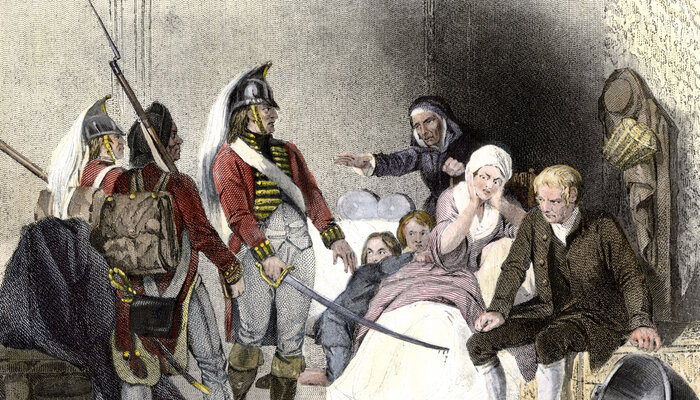Amendment III
No Soldier shall, in time of peace be quartered in any house, without the consent of the Owner, nor in time of war, but in a manner to be prescribed by law.
One thing we learned about the Constitution during Donald Trump’s presidency is that there are dead zones in the hallowed document that aren’t likely to be revived anytime soon. We now know, for example, that the federal courts aren’t ready or willing to enforce the “Emoluments Clauses” of the Constitution, Article I, Section 9. The Supreme Court without comment dismissed two emoluments cases in January 2021 despite ample evidence that Trump violated them through revenue from the Trump Hotel and some of his other businesses.
Other dead areas of the Constitution — amendments, articles, provisions, and clauses that draw virtually no litigation — preceded the Trump era and will surely last far beyond it. Into this category goes the Third Amendment, the part of the Bill of Rights that was designed to protect the colonialists from being forced to house British soldiers in the decades leading up to the Revolutionary War. Since there no longer are any British soldiers hanging around, and since active U.S. military personnel tend to live on military bases, there simply aren’t any litigants asserting the rights and privileges of the Third Amendment.
No litigants means no new case law. And no new case law means little work for law professors, historians, and others who are interested in why the drafters of the Bill of Rights felt the need to place the no-quartering-of-soldiers amendment third in the pecking order, before other amendments that are far more prominent and controversial today. The Sixth Amendment, for example, guarantees fair trial rights, and the Eighth Amendment is supposed to protect us from “cruel and unusual punishment.” These vital protections came after the one protecting people from soldiers, even though the Supreme Court has never decided a case on the basis of the Third Amendment, and it remains the least litigated of all of the constitutional amendments.
As part of the Brennan Center’s continuing series on the Bill of Rights, I reached out to Leonard Niehoff, a professor from practice at the University of Michigan. Among other subjects, he keeps apprised of developments, rare as they are, in Third Amendment law.
COHEN: Are there any pending cases that you are watching in which lawyers or litigants have raised a Third Amendment claim? If so, tell me a little about that case. If not, tell me when the Third Amendment last made an appearance in a federal appeals court decision.
NIEHOFF: Third Amendment cases remind me of those giant prehistoric fish that scientists once believed to be extinct but that are found in nets every few decades. The forced quartering of soldiers doesn’t come up much, but we can’t quite declare it extinct. I’m not aware of any current cases that raise a major Third Amendment claim, and I can’t say with confidence when a federal case last referred to it. A candidate for that honor might be Mitchell v. City of Henderson, a 2015 case from the federal district court in Nevada. There, the plaintiffs alleged that police officers brutally forced them to leave their home so they could occupy it to gain a tactical advantage in handling a domestic violence incident happening next door. The plaintiffs claimed that this conduct violated the Third Amendment, among other things. The court concluded that it didn’t because (a) police officers aren’t soldiers and (b) occupying the premises for less than 24 hours didn’t amount to quartering.
COHEN: So what does Third Amendment scholarship focus on these days in the absence of pending case law? Is anyone offering any new historical analysis or provocative theories about how the Third Amendment can or should be applied to modern circumstances?
NIEHOFF: I think the Supreme Court may recently have opened up new possibilities for Third Amendment scholarship and litigation. To the extent courts have bothered with the Third Amendment at all, they have generally limited it to its literal terms. We see this in the Nevada case I just mentioned. But in the Bruen case, where the Supreme Court struck down a 100-year-old New York State firearm regulation under the Second Amendment, Justice Clarence Thomas stressed the importance of using analogies to understand the meaning of a constitutional provision.
One could argue that this isn’t coherent: it would seem that a strict originalist shouldn’t care about analogous contemporary situations that the Founders didn’t anticipate. But Justice Thomas had to make this concession. Vast swaths of our First Amendment case law work by historical analogy. That’s how “speech” ends up protecting social media posts on the Internet. And (of greatest concern to Justice Thomas in that moment) without the use of analogies, the Second Amendment wouldn’t extend to modern weapons like semi-automatic handguns. This raises the interesting question: What sorts of situations are analogous to the forced quartering of soldiers in the home?
COHEN: Okay, I’ll bite. What sorts of situations are analogous to the forced quartering of soldiers in the home? Is there a Third Amendment component to the decision by governors to send National Guard troops to the border to perform law enforcement operations against asylum seekers and other migrants? If not, where are we most likely to next see an attorney or a judge invoke the Third Amendment?
NIEHOFF: Yes, that’s the idea. Any time the government occupies private property for military or quasi-military purposes, we might go analogy hunting. Could that include law enforcement purposes? It seems plausible, particularly with the increasing militarization of police forces. How will we know when an analogy is too strained? We won’t. When will we know? When the Supreme Court tells us.
COHEN: So what animates your thoughts about the Third Amendment these days? Where have you landed after your years of research on it? Is it likely to be used in the next decade to justify a decision that protects a homeowner from a troop of militarized police? Are there advocates out there who are pressing to make it relevant in 2022?
NIEHOFF: To be clear, although I’ve written a little about the Third Amendment, I haven’t conducted years of research into it, and, frankly, I don’t know anyone who has. Getting tenure on the strength of the Third Amendment would be a tall order. With that said, it’s a fascinating field to watch, particularly if lawyers begin arguing that cases like Bruen invite the use of the analogical imagination, an approach for which literalist courts have shown little sympathy. Observing Third Amendment litigation is a bit like hiking in Tibet looking for a snow leopard; the mere prospect of seeing one rewards the watching. I hope you didn’t miss the stretch of analogical muscle there.
COHEN: I probably don’t have to tell you that most folks don’t spend much time thinking about the contours of the Third Amendment. Is there any particularly smart academic work or other scholarship you can direct them to if people are interested in how that amendment might be applied in our current political and legal context?
NIEHOFF: Most of the research of which I’m aware focuses on relatively narrow historical questions, like the extent to which the quartering of soldiers was actually allowed. For people who’d just like a little more information about the amendment, the historian Gordon Wood has a lovely short essay published online by the Constitution Center that they might enjoy reviewing. I spend most of my time reading about other amendments, especially the First, which is the subject of a book I’ve just published with Cambridge University Press. I assume that such a shameless plug will leave you with no further questions.
This interview has been edited for length and clarity.
This discussion is one of several in a Brennan Center series on the Bill of Rights. The interview with Darrell Miller about the Second Amendment is here, the interview with Orin Kerr about the Fourth Amendment is here, the interview with David Carroll about the Sixth Amendment is here, the interview with Carol Steiker about the Eighth Amendment is here, and the interview with Jessica Bulman-Pozen about the Tenth Amendment is here.


